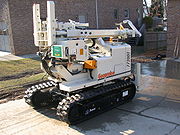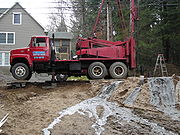
Direct exchange geothermal heat pump
Encyclopedia
A direct exchange geothermal heat pump system is a geothermal heat pump system in which the refrigerant
circulates through copper
tubing placed in the ground. The refrigerant
exchanges heat directly with the soil through the walls of the copper tubing. This eliminates the plastic water pipe and water pump to circulate water found in a water-source geothermal heat pump. This simplicity allows the system to reach high efficiencies while using a relatively shorter and smaller set of buried tubing, reducing installation cost. DX systems, like water-source systems, can also be used to heat water in the house for use in radiant heating
applications and for domestic hot water, as well as for cooling applications.
For information on water-source systems, see the article on geothermal heat pump.
Gradually developing since the 1970s, DX technology is now experiencing a surge in popularity among homeowners and small businesses due to high energy costs. There is also increasing awareness of environmental and energy issues among urban and suburban residents with limited space in which to install a system.

 Because of their small earth loop size, DX systems can be installed in relatively small areas and in relatively shallow soil. This provides a flexibility of installation that is useful in allowing many properties to be served by geothermal that could not be served otherwise. A direct exchange system ground loop can be drilled with a small drill rig that can fit into small side yards and gardens under existing trees. It can be drilled in areas where rock is found 50 feet (15.2 m) to 100 feet (30.5 m) below ground without the need for actually drilling into rock.
Because of their small earth loop size, DX systems can be installed in relatively small areas and in relatively shallow soil. This provides a flexibility of installation that is useful in allowing many properties to be served by geothermal that could not be served otherwise. A direct exchange system ground loop can be drilled with a small drill rig that can fit into small side yards and gardens under existing trees. It can be drilled in areas where rock is found 50 feet (15.2 m) to 100 feet (30.5 m) below ground without the need for actually drilling into rock.
Because DX derives its efficiency from the direct heat exchange between refrigerant and ground, the compressor
unit cannot be placed at great distance from the earth loops. This can limit some DX applications. However, the use of multiple distributed compressor units on a single project can allow DX systems to serve large buildings.
s, and several earth loops. The line set is the pair of main copper pipes coming from the heat pump compressor unit, usually located indoors. One line is for the liquid refrigerant, the other is for gaseous refrigerant. The line set runs through the building wall and runs underground to the location of the manifolds. Each manifold (one for gas and one for liquid) serves to allow a main pipe to be attached to the earth loops which exchange heat with the ground.
The earth loops can be installed vertically, diagonally or horzontally 6 feet (1.8 m) deep and laying the earth loops on the bottom of the pit before installation is done by drilling several borehole
s radiating outward from the manifolds and placing an earth loop into each of the boreholes. After the earth taps are placed, the boreholes are then filled with grout
for good thermal contact between loop and soil.
The boreholes are drilled to a length of 50, 75 or 100 ft (15, 22 or 30 m) with a diameter of 3 inches (76.2 mm). A total of 100 feet (30.5 m) to 140 feet (42.7 m) of drilling is needed for each ton (3.5 kWth) of system capacity.
Because copper is a naturally-occurring metal that survives in the ground for thousands of years in most soil conditions, the copper loops have a very long lifetime in most soil conditions.
Corrosion of the copper earth loop in acidic soil can be eliminated through installation of a sacrificial anode.
Refrigerant
A refrigerant is a substance used in a heat cycle usually including, for enhanced efficiency, a reversible phase change from a liquid to a gas. Traditionally, fluorocarbons, especially chlorofluorocarbons, were used as refrigerants, but they are being phased out because of their ozone depletion...
circulates through copper
Copper
Copper is a chemical element with the symbol Cu and atomic number 29. It is a ductile metal with very high thermal and electrical conductivity. Pure copper is soft and malleable; an exposed surface has a reddish-orange tarnish...
tubing placed in the ground. The refrigerant
Refrigerant
A refrigerant is a substance used in a heat cycle usually including, for enhanced efficiency, a reversible phase change from a liquid to a gas. Traditionally, fluorocarbons, especially chlorofluorocarbons, were used as refrigerants, but they are being phased out because of their ozone depletion...
exchanges heat directly with the soil through the walls of the copper tubing. This eliminates the plastic water pipe and water pump to circulate water found in a water-source geothermal heat pump. This simplicity allows the system to reach high efficiencies while using a relatively shorter and smaller set of buried tubing, reducing installation cost. DX systems, like water-source systems, can also be used to heat water in the house for use in radiant heating
Radiant heating
Radiant heating is a technology for heating indoor and outdoor areas. Heating by radiant energy is observed everyday, the warmth of the sunshine being probably the most commonly observed example. Radiant heating as a technology is typically more narrowly defined...
applications and for domestic hot water, as well as for cooling applications.
For information on water-source systems, see the article on geothermal heat pump.
History
The first geothermal heat pump was a DX system built in the late 1940s by Robert C. Webber. Later designs incorporated an additional plastic pipe loop to circulate water in deep wells in an effort to gather sufficient heat for large industrial applications such as cement plants. Thus water-source technology advanced due to industrial interest while DX, more suited to smaller projects such as small businesses and private homes, lagged behind.Gradually developing since the 1970s, DX technology is now experiencing a surge in popularity among homeowners and small businesses due to high energy costs. There is also increasing awareness of environmental and energy issues among urban and suburban residents with limited space in which to install a system.
Applications


Because DX derives its efficiency from the direct heat exchange between refrigerant and ground, the compressor
Gas compressor
A gas compressor is a mechanical device that increases the pressure of a gas by reducing its volume.Compressors are similar to pumps: both increase the pressure on a fluid and both can transport the fluid through a pipe. As gases are compressible, the compressor also reduces the volume of a gas...
unit cannot be placed at great distance from the earth loops. This can limit some DX applications. However, the use of multiple distributed compressor units on a single project can allow DX systems to serve large buildings.
Ground loop configuration
The copper tubing consists of a line set, a pair of manifoldManifold (general engineering)
A manifold, in systems for moving fluids or gases is a junction of pipes or channels, typically bringing one into many or many into one.-Applications:*Heated-manifold direct-injection die casting for zinc die casting....
s, and several earth loops. The line set is the pair of main copper pipes coming from the heat pump compressor unit, usually located indoors. One line is for the liquid refrigerant, the other is for gaseous refrigerant. The line set runs through the building wall and runs underground to the location of the manifolds. Each manifold (one for gas and one for liquid) serves to allow a main pipe to be attached to the earth loops which exchange heat with the ground.
The earth loops can be installed vertically, diagonally or horzontally 6 feet (1.8 m) deep and laying the earth loops on the bottom of the pit before installation is done by drilling several borehole
Borehole
A borehole is the generalized term for any narrow shaft bored in the ground, either vertically or horizontally. A borehole may be constructed for many different purposes, including the extraction of water or other liquid or gases , as part of a geotechnical investigation, environmental site...
s radiating outward from the manifolds and placing an earth loop into each of the boreholes. After the earth taps are placed, the boreholes are then filled with grout
Grout
Grout is a construction material used to embed rebars in masonry walls, connect sections of pre-cast concrete, fill voids, and seal joints . Grout is generally composed of a mixture of water, cement, sand, often color tint, and sometimes fine gravel...
for good thermal contact between loop and soil.
The boreholes are drilled to a length of 50, 75 or 100 ft (15, 22 or 30 m) with a diameter of 3 inches (76.2 mm). A total of 100 feet (30.5 m) to 140 feet (42.7 m) of drilling is needed for each ton (3.5 kWth) of system capacity.
Because copper is a naturally-occurring metal that survives in the ground for thousands of years in most soil conditions, the copper loops have a very long lifetime in most soil conditions.
Corrosion of the copper earth loop in acidic soil can be eliminated through installation of a sacrificial anode.
System sizing
DX systems are currently manufactured in sizes from 1.5 tons (5.25 kWth) to 6 tons (21 kWth). Larger projects can be accomplished through installation of multiple units.See also
- Absorption heat pumpAbsorption heat pumpAbsorption heat pump is essentially an air-source heat pump driven not by electricity, but by a heat source such as solar-heated water, or geothermal-heated water...
- Geothermal heatingGeothermal heatingGeothermal heating is the direct use of geothermal energy for heating applications. Humans have taken advantage of geothermal heat this way since the Paleolithic era. Approximately seventy countries made direct use of a total of 270 PJ of geothermal heating in 2004...
and cooling - Earth cooling tubesEarth cooling tubesA ground-coupled heat exchanger is an underground heat exchanger loop that can capture or dissipate heat to or from the ground. They use the Earth's near constant subterranean temperature to warm or cool air or other fluids for residential, agricultural or industrial uses...
- Geothermal heat pump
- Geothermal powerGeothermal powerGeothermal energy is thermal energy generated and stored in the Earth. Thermal energy is the energy that determines the temperature of matter. Earth's geothermal energy originates from the original formation of the planet and from radioactive decay of minerals...

